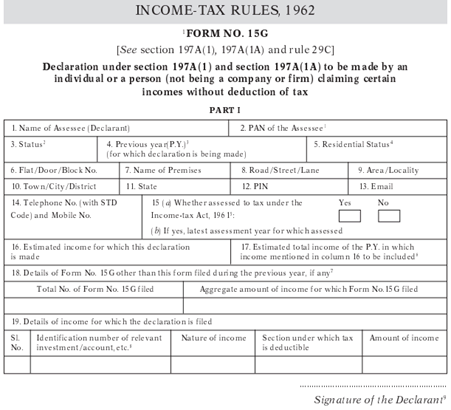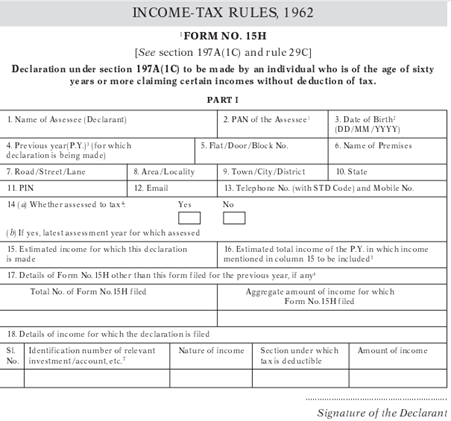Master Form 15G and 15H to Stop TDS in Its Tracks
Managing your finances efficiently involves minimizing tax deductions wherever legally possible. One common concern for individuals is the Tax Deducted at Source (TDS) on interest income. If your total income is below the taxable threshold, you can use Form 15G or Form 15H to request non-deduction of TDS. Let’s explore these forms in detail, understand their application, and clarify the difference between Form 15G and Form 15H.
What Are Form 15G and Form 15H?
Form 15G and Form 15H are self-declaration forms that taxpayers submit to their bank or other deductors to prevent TDS on interest income if their income is below the basic exemption limit. Submitting these forms helps ensure that no TDS is deducted on eligible incomes such as interest on fixed deposits, recurring deposits, or other specified incomes.
Key Features:
- Form 15G is applicable for resident individuals below 60 years of age, HUFs, and trusts.
- Form 15H is for senior citizens aged 60 years or above.
- Submission of PAN is mandatory when submitting these forms.
- These forms can often be submitted online through your bank’s website.
Eligibility Criteria for Form 15G and Form 15H
Form 15G
- You must be a resident individual, HUF, or trust (not applicable to companies or firms).
- Your tax liability on total income should be nil.
- Your total interest income for the year must be below the basic exemption limit:
- Rs. 2.5 lakh (old regime) or Rs. 3 lakh (new regime) for FY 2023-24.
Form 15H
- You must be a resident individual aged 60 years or above (senior citizen).
- Your total tax liability on income, after deductions, should be nil.
Note: Non-residents cannot claim the benefits of these forms.
Examples to Understand Eligibility
| Age | Income Type | Total Income | Deductions | Taxable Income | Eligible form |
|---|---|---|---|---|---|
| 50 | Salary + FD Interest | Rs. 2,65,000 | Rs. 45,000 | Rs. 2,20,000 | Form 15G |
| 21 | FD Interest Only | Rs. 2,60,000 | Rs. 30,000 | Rs. 2,30,000 | Not Eligible |
| 65 | Pension + FD Interest | Rs. 2,80,000 | Rs. 10,000 | Rs. 2,70,000 | Form 15H |
| 68 | FD Interest Only | Rs. 3,30,000 | Rs. 55,000 | Rs. 2,75,000 | Form 15H |
Difference Between Form 15G and Form 15H
| Aspect | Form 15G | Form 15H |
|---|---|---|
| Type of Taxpayer | Residents below 60 years of age, HUF, or trust | Senior citizens aged 60 or above |
| Basic Exemption Limit | Below Rs. 2.5/3 lakh (depending on regime) | Not required |
| Tax Liability Condition | Nil tax on total income | Nil tax on total income |
Form 15G Sample

Form 15H Sample

When Should You Submit Form 15G and Form 15H?
It’s crucial to submit these forms at the beginning of the financial year to ensure no TDS deduction occurs. These forms are valid only for one financial year, so they need to be renewed annually.
What Happens If You Forget to Submit?
If you forget to submit Form 15G or Form 15H, the bank or deductor may already have deducted TDS. Here’s how you can resolve the issue:
- File an Income Tax Return (ITR) to claim a refund for the excess TDS deducted.
- Submit the form immediately to prevent further deductions for the remaining financial year.
Where Can You Submit Form 15G or Form 15H?
Besides banks, these forms can be submitted in the following scenarios:
PF Withdrawal
If withdrawing EPF before five years of service, and the amount exceeds Rs. 50,000, submit Form 15G or PF Withdrawal Form 15G.
Corporate Bonds
Submit the form to avoid TDS if income exceeds Rs. 5,000.
LIC Maturity Proceeds
To avoid TDS on proceeds above Rs. 1 lakh.
Post Office Deposits
Digitized post offices also accept these forms.
Rental Income
If rent exceeds Rs. 2.4 lakh annually.
Insurance Commission
For commission income exceeding Rs. 1.5 lakh.
Dividends
Submit the form if dividend income exceeds Rs. 5,000.
How to Download Form 15G and Form 15H?
You can easily download Form 15G and download Form 15H from your bank’s website or the Income Tax Department’s official portal. Many banks offer online submission options, simplifying the process for customers.
How to Fill Form 15G?
- Name and PAN Details: Enter your name and PAN number as per official records.
- Residential Status: Confirm that you are a resident.
- Income Details: Include all sources of income and tax liability calculations.
- Previous Filings: Mention any earlier Form 15G submissions in the year.
- Signatures: Ensure proper signing if filing for HUF or AOP.
Important Note: Do not submit Form 15G if the income is clubbed with another person’s income, such as a non-earning spouse or child.
Important Information for TDS Deductors
Deductors must assign a Unique Identification Number (UIN) to each submitted form and file quarterly statements. Retain the forms for a minimum of seven years as per the Income Tax Act.
In conclusion, using Form 15G or Form 15H effectively can save you from unnecessary TDS deductions. Make sure you meet the eligibility criteria, submit these forms on time, and check with your bank for online submission options. By staying informed, you can manage your taxes efficiently and avoid delays in refunds. Whether it’s PF withdrawal Form 15G, corporate bond interest, or post office deposits, these forms are vital tools in your financial toolkit.
Explore TaxSpanner's wide range of calculators for your tax planning and calculations!
View Tools & Calculators




